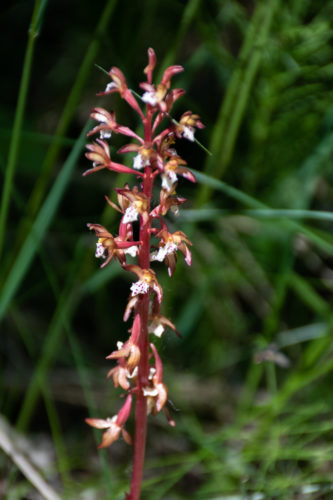Spotted Coral Root Orchid (Corallorhizea maculata) is a saprophyte, a plant that roots in dead material, symbiotically sharing its substrate with fungi. “Coral root” refers to the stubby roots looking like branched coral (Gadd 302).
[lgc_column grid=”50″ tablet_grid=”50″ mobile_grid=”100″ last=”false”]
Coral roots are sometimes referred to as ‘chicken-toes’ (Parish 282).
Saprophytes cannot be cultivated. Because of their dependency on decaying matter, coral roots will grow wherever dead material happens to be. In other words, this plant may be “abundant in one part of the forest floor one year and completely absent the next year” (Parish 282).
The term ‘spotted’ (maculate) refers to the spots seen on the flowers (Parish 283). Another distinctive feature is the lack of any green parts (leaves).
Sources:
- Gadd, Ben. Handbook of the Canadian Rockies
- Parish, Coupé, Lloyd. Plants of Southern Interior B.C.
[/lgc_column]
[lgc_column grid=”50″ tablet_grid=”50″ mobile_grid=”100″ last=”true”]
WASKAHEGAN FIELD NOTES
Generally, wild orchids are a rare sight, found only in undisturbed environments. Aren’t we lucky to have the opportunity to walk—carefully—through their habitat! We found these orchids and took pictures in late June, along the Pipestone Creek trail, in a low-lying, moist area of otherwise dry north-facing slope of the creek’s valley.
FYI: These “seepage slopes” occur throughout forests on hillsides where the water table is curved downward as in large river valleys or where the water bearing sand/gravel layers come to the surface for other reasons (artesian seeps). A large agricultural field which slopes into a river valley is also prone to have runoff during rainy weather. North facing slopes are the wettest otherwise because they have the lowest solar input to keep things dry. (Jerry Shaw)
[/lgc_column]

